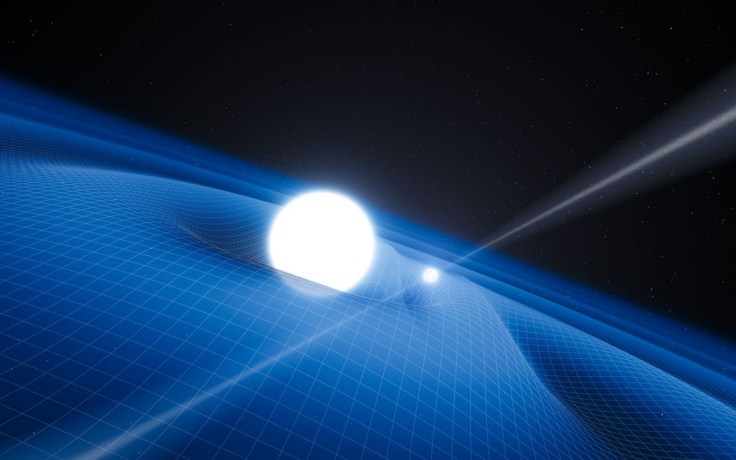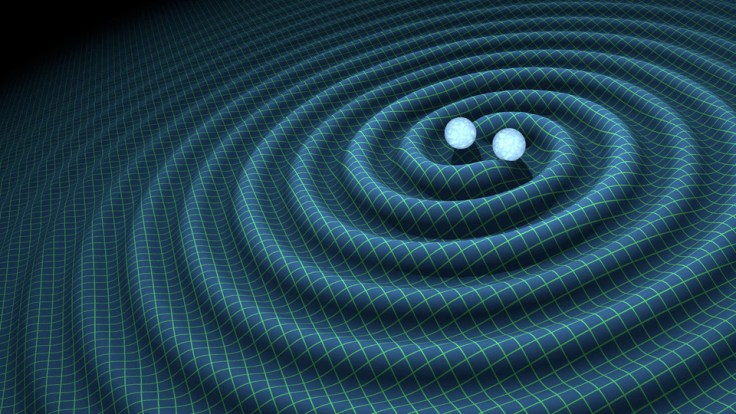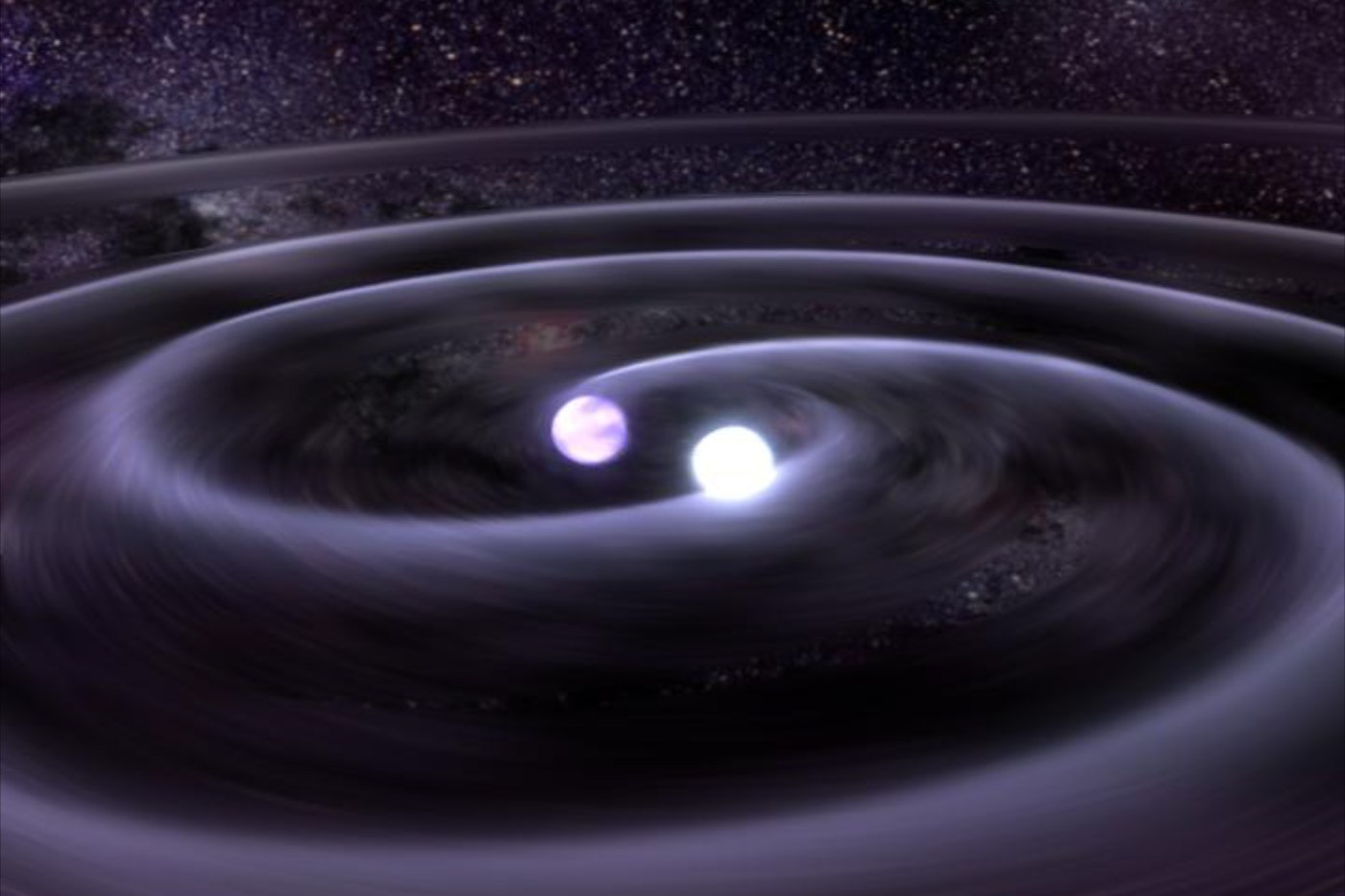Exactly 100 years ago in 1916, Albert Einstein published a paper entitled Approximate Integration of the Field Equations of Gravitation. In this paper he introduced gravitational waves to the General theory of Relativity. It now seems in light of recent rumours we may have finally stumbled across evidence supporting the existence of gravitational waves. Speculation has it that the announcement is set to be made in the coming hours, so until then we’ll just have to hold tight. But that won’t stop us from having a look at what gravitational waves really are, and the speculation surrounding their existence.
— What are Gravitational Waves? —
Gravitational waves are ripples propagating through the fabric of spacetime. This fabric which we term spacetime consists of three dimensions of space coupled with one dimension of time. Just like dropping a pebble in a pond, gravitational waves represent spacetime itself ‘waving’ rather than radiation propagating through spacetime such as the more familiar electromagnetic radiation. Just like the pebble, these waves are produced when masses move through spacetime. However it is not the simple movement of these masses which produces this gravitational radiation – it is their acceleration. At least two masses are necessary for acceleration; one mass creates a gravitational field by warping the spacetime around the second mass, resulting in accelerations for both.

The ripples which result act as a mechanism to carry energy away from the masses undergoing the accelerations, in turn meaning that the orbits of our binary star system we described previously will undergo a decay. However these decays are virtually unnoticeable in the average system such as the Earth-Sun system due to how weak these gravitational waves actually are.
— Why they are so hard to detect —
Max Abraham, a theoretical physicist who was a dedicated proponent of the electromagnetic worldview (a view which sought to explain all physics phenomena as arising out of the electromagnetic field and ether), surprisingly provided a very important calculation before Einstein’s paper in 1916. Although opposing the theory of relativity, Abraham was the first person to recognise that there can be no such thing as dipole gravitational radiation. Let’s have a look at what that actually means.

The following description of multipole radiation is a summary from ‘Travelling at the speed of thought‘ written by Daniel Kennefick (see page 36).
(a) Monopole radiation: can only be caused by a change in the source that is spherically symmetric. But purely radial oscillations do not change any inverse-square law fields (such as electromagnetism and gravity).
(b) Dipole radiation: an accelerating source, for instance one that moves back and forwards along a straight line. This works fine in electromagnetism, however in the case of gravity the conservation of momentum demands that for each moving mass there is a mass with equal momentum moving oppositely, and hence cancelling out any change in the field.
(c) Quadrupole radiation: produced when the source changes about two axes (hence four poles). This type of radiation is the weakest (and hardest to detect). Removing the bar in between the two ends gives a real life example of a binary star system (two stars orbiting each other).
It is important to realise that higher order does not refer to a higher frequency (or energy). In fact, the greatest part of energy radiated is in the lowest order multipole and successively less and less in each successive at each higher order. Since the monopole does not affect either the electromagnetic or gravitational field, it can be ignored. What we thus see is the same observation that Abraham made – namely, electromagnetic radiation is dominated by dipole radiation and gravitational radiation is dominated by quadrupole radiation, meaning that gravity waves are much, much harder to detect the than normal electromagnetic radiation.

This is why physicists look towards binary star systems – usually two (very dense) neutron stars rotating in orbit around each other. Since they are so massive and are accelerating at ridiculous values, they produce they largest gravity waves giving us the best chance at finding them.
— LIGO: The final key? —
The Laser Interferometer Gravitational-Wave Observatory, or LIGO for short, is one of the most sensitive large scale experimental devices built to date. Its sole task is to detect the ever elusive gravity waves which have evaded measurement for nearly a century. And after over 20 years of hard work between more than 900 collaborators, they may have finally succeeded in their goal. Only time will tell.
Gravitational waves work by compressing and then expressing spacetime in directions perpendicular to one another. Advanced LIGO works by firing two lasers of identical wavelengths perpendicular to each another down a tunnel four kilometers long in either direction. These lasers bounce off of mirrors many times over (effectively increasing the path-length to thousands of kilometers), and then brings them back together, where they create an interference pattern with one another.

This system has been set up so that under normal conditions the lasers undergo destructive interference – that is, each ray is 180 degrees out of phase with each other (in essence cancelling each other out). This leads to a null signal. However in the presence of gravitational waves, the surrounding space will become distorted such that the light rays become shifted and will no longer perfectly cancel each other out. In other words, a small but finite signal will materialise.

To ensure that this signal is not a false alarm there are two separate systems set up (one in Washington, the other in Louisiana). The signal has to be detected by both sites in order to rule out any other anomalies that may be creating a phantom signal such as a minor earthquake or the rumbling of a nearby truck (yes, that is how sensitive these detectors are).
— If found, what will this mean? —
In my celebration of Einstein’s General theory of Relativity, I mentioned how the prediction of gravitational waves were the final piece to complete the puzzle. If confirmed, then the existence of gravitational waves will be yet another success in proving Einstein was right about GR.
Their real value though comes in allowing us to probe the dark universe – things such as black holes and neutron stars, along with other particles that interact only very weakly with the electromagnetic field. Gravitational waves are able to pass right through these objects, potentially providing us with a way to see what lies inside these mysterious objects.

While it seems as if the announcement is verging on inevitable, we have to hang tight. You never know – what would be more surprising (and definitely more interesting) is if the group at LIGO come out with a completely unexpected result.
Sources:
[1] – Travelling at the speed of thought, Daniel Kennefick.
[2] – LIGO. https://www.ligo.caltech.edu/
[3] – What Will It Mean If LIGO Detects Gravitational Waves? by Eithan Segal, Forbes 2016. Available at: http://www.forbes.com/sites/startswithabang/2016/02/09/what-will-it-mean-if-ligo-detects-gravitational-waves/#56caa72e4726
[4] – Why Finding Gravitational Waves Would Be Such a Big Deal by Maddie Stone, Gizmodo 2016. Available at http://gizmodo.com/heres-why-finding-gravitational-waves-would-be-such-a-b-1752286165


Cool blog… Maybe our ideas and topics intersect😄😄
LikeLiked by 1 person
Thanks and definitely! To put it simply, physics is pretty awesome 🙂
LikeLiked by 1 person
Yeah
LikeLike